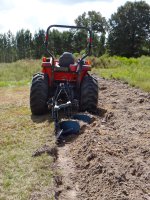I've done some searching in the forums and online along with talking to a couple people in person, but I still don't feel like I have a good grasp on what implements I need that will be a good balance of getting the job done along with cost of the implement / implements.
I know there are several variables out there that will effect the answer you can give so ill give as much detail as possible. I have about 2-3 acres of flat virgin ground that I plan on planting a wide variety of crops, including corn, soy bean, potatoes, and other vegetables in the spring/summer along with growing grains such as oat and wheat in the fall/winter. I am unsure of what the soil type that I have would be called, but I can tell you that it's dark colored soil thats not rocky and not full of clay or sand and it holds water a little better than I would like. I will be doing my plowing with a Ford 2000 3 cyl gasser.
To my main question that I seem to be having trouble on deciding on, is what would be best for me to buy to help me get my plowing needs done? Will discs do the job alone on my virgin ground and be sufficient for continued maintanence? Or do I 'have' to get a plow to use first and then run the discs over them (yes I do know that this would be the "proper" way but am trying to keep costs down if possible).
Using a bottom plow by itself was the other thing I was wondering about. My thoughts are if I only use this, there will be big chunks of dirt and uneven ground as a final product. Are thoughts correct here?
I guess the last option, but most expensive option, would be a rotary tiller? Will they do the job 100% without the help of another implement? If so, what size would you recommend for my ford 2000?
I know there are several variables out there that will effect the answer you can give so ill give as much detail as possible. I have about 2-3 acres of flat virgin ground that I plan on planting a wide variety of crops, including corn, soy bean, potatoes, and other vegetables in the spring/summer along with growing grains such as oat and wheat in the fall/winter. I am unsure of what the soil type that I have would be called, but I can tell you that it's dark colored soil thats not rocky and not full of clay or sand and it holds water a little better than I would like. I will be doing my plowing with a Ford 2000 3 cyl gasser.
To my main question that I seem to be having trouble on deciding on, is what would be best for me to buy to help me get my plowing needs done? Will discs do the job alone on my virgin ground and be sufficient for continued maintanence? Or do I 'have' to get a plow to use first and then run the discs over them (yes I do know that this would be the "proper" way but am trying to keep costs down if possible).
Using a bottom plow by itself was the other thing I was wondering about. My thoughts are if I only use this, there will be big chunks of dirt and uneven ground as a final product. Are thoughts correct here?
I guess the last option, but most expensive option, would be a rotary tiller? Will they do the job 100% without the help of another implement? If so, what size would you recommend for my ford 2000?
